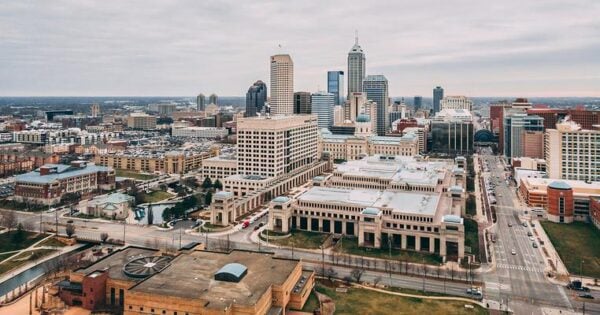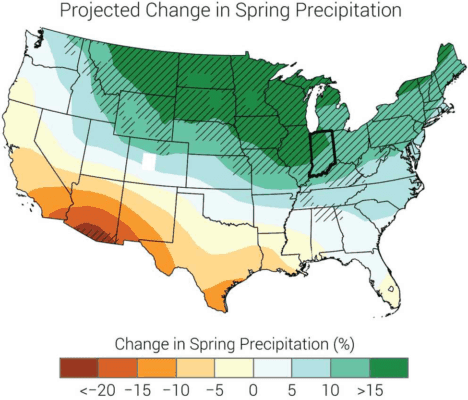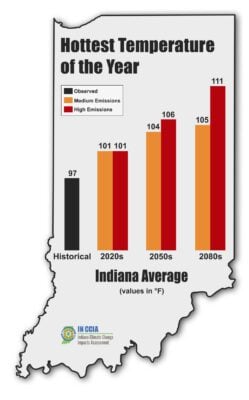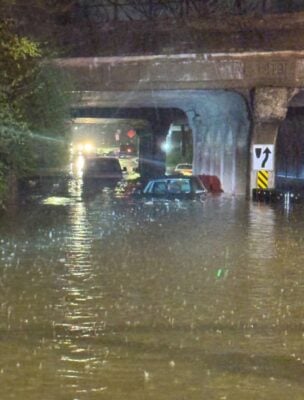In Indianapolis, climate change is not just a future threat — it is already worsening heat, flooding and air quality.
Those harms disproportionately affect underserved populations, particularly in historically marginalized neighborhoods.
Rising heat hits the most vulnerable
Temperatures across Indiana have risen by over 2.2°F in the last century, and average annual temperatures are projected to rise another 5-6°F by 2050. This translates into far more days over 95°F each year, rising from around seven per year today to as many as 51 in southern Indiana by midcentury.
Urban heat island effects mean that two-thirds of Indianapolis residents live in neighborhoods where summer heat is amplified by at least 8°F due to concrete, asphalt and minimal greenery. In historically redlined areas, often home to Black, low-income and immigrant communities, temperatures remain hotter into the night, exacerbating heat stress.
These underserved neighborhoods often lack robust tree canopy, ranging from as little as 3% canopy cover in some areas, compared to over 78% in wealthier parts of the city, resulting in significantly less natural cooling.

Health threats
Extreme heat contributes to heat-related illnesses and deaths, particularly among the elderly, young children and people with chronic conditions. Heat also worsens air quality by increasing ground-level ozone. Residents in low-income neighborhoods, often near highways or industrial sites, already suffer elevated levels of ozone and other pollutants.
A Fair Housing Center report shows nearly 800,000 Indiana residents are vulnerable to inland flooding exacerbated by climate change, with more than 270,000 in areas at direct flood risk, disproportionately including those in underserved communities. More intense rainfall, up to 35% heavier during the four wettest days, is overwhelming sewer systems and increasing flood damage.
Power outages also follow climate hazards: national studies show that in events like Winter Storm Uri or Hurricane Ida, lower-income and communities of color endure longer, more frequent outages, a pattern likely to occur during heat waves or flooding as well.

Why underserved communities bear the brunt
1. Legacy of redlining and urban planning inequity
Historic redlining in Indianapolis relegated non-white, low-income residents to neighborhoods with poor infrastructure, limited tree cover and proximity to highways and industrial zones. These design decisions now translate into hotter, more polluted conditions and higher exposure to environmental risks.
2. Economic and social vulnerability
Residents in these communities are less likely to have access to reliable and affordable air conditioning and face higher energy burdens, leading to greater risk during prolonged heat. They are also more likely to work outdoors in construction, landscaping or delivery, exposing them to heat stress for longer periods.
Disparities in health care access and chronic disease prevalence especially asthma, diabetes and hypertension amplify heat-related impacts in low-income and communities of color, who are also more likely to live near pollution sources like highways.
3. Exposure to flooding and infrastructure fragility
Low-income neighborhoods often reside in lower-lying areas, closer to flood zones, and have less robust infrastructure to manage stormwater and drainage. Historic underinvestment means these communities face more frequent and severe flooding, property damage and displacement risk.

Local efforts & resources
Thrive Indianapolis
Launched in 2019, Thrive Indianapolis is the city’s sustainability and resilience action plan. It includes 59 actions, 13 completed to date, aiming to build resilience in the built environment, public health, natural resources, and more. The plan emphasizes environmental equity, including mapping hotspots and prioritizing underserved neighborhoods in climate adaptation planning.
Targeted tree planting & cooling infrastructure
City and partner organizations such as Keep Indianapolis Beautiful are prioritizing tree planting, park expansion and reflective surface projects in historically underserved areas to mitigate urban heat islands.
Social vulnerability mapping
The Hoosier Resilience Index maps social vulnerability based on 12 socio-economic factors per census tract, helping the city identify and target neighborhoods that need the most support in responding to extreme heat, flooding and other climate shocks.
Community cooling & energy assistance
Some local nonprofits and city programs offer cooling centers, summer water stations and utility bill assistance aimed at residents in high-risk, underserved areas. Community-led groups advocate for better housing, climate-informed health outreach and equitable access to clean energy upgrades.

Why equity matters in climate action
Because climate hazards amplify existing inequities in health, wealth and infrastructure access, true resilience must be equity focused. Without directing resources where they are most needed, climate adaptation can deepen disparities.
Studies from the U.S. Environmental Protection Agency confirm that Black, low-income and less-educated individuals face higher exposure to temperature-related death risks, childhood asthma increases and pollution-related illnesses compared to other groups. National research likewise shows that underserved communities endure more power outages during climate events and face longer recovery times.
This reporting is made possible by a grant from the Indianapolis African-American Quality of Life Initiative, empowering our community with essential health insights. https://iaaqli.org/
Contact Health & Environmental Reporter Hanna Rauworth at 317-762-7854 or follow her on Instagram at @hanna.rauworth.
Hanna Rauworth is the Health & Environmental Reporter for the Indianapolis Recorder Newspaper, where she covers topics at the intersection of public health, environmental issues, and community impact. With a commitment to storytelling that informs and empowers, she strives to highlight the challenges and solutions shaping the well-being of Indianapolis residents.





